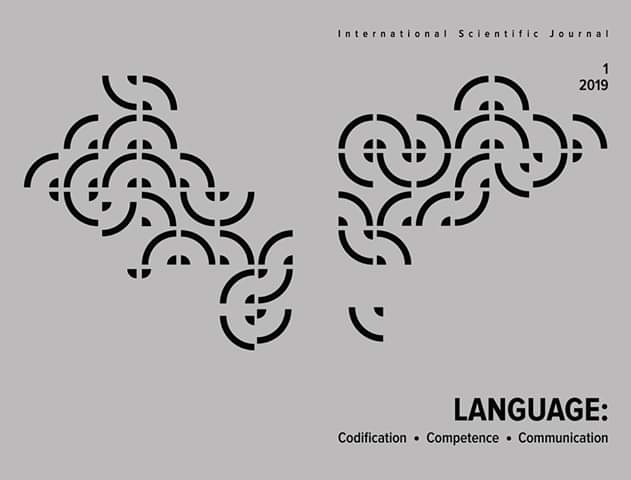PLACES MEMORABLE AS A PROBLEM OF LINGUISTIC AND CULTURAL ADAPTATION IN THE PROCESS OF LITERARY TRANSLATION (ON THE MATERIAL OF THE UKRAINIAN TRANSLATION OF G. GRASS’S NOVEL "MY CENTURY")
DOI:
https://doi.org/10.24025/2707-0573.1.2019.169826Abstract
Background. In the proposed article the places memorable are considered from the point of view of translation studies and the theory of cross-cultural communication, namely the features of the literary translation according to the national-cultural asymmetry. Although this problem is not new, and it should be mentioned about the study of national and cultural features of literary translation in connection with their important role in the transfer of a foreign literary work in the language of translation, it would be appropriate to note that, first of all, in the modern linguistic paradigm, language is considered as a cultural code of the nation, and the literary text provides material for reading this code. Therefore, it is necessary to study the national and cultural specificity of language units of the literary text and their translation, as well as the study of ways to reflect the national character, mentality and worldview of an ethnic group in the space of literary works.
The purpose of the article is to make the analysis of the Ukrainian translation of the novel of the German writer G. Grass’s "My century" from the point of view of reproduction places the memorable in the process of literary translation, namely such categories as commemorative, symbolic and communication places.
Methods. In the process of research various research methods are used, namely comparative and descriptive methods, transformational and linguistic-stylistic analysis, modern research on the problems of memorable discourse, modern theories of chronotope, of the hermeneutics and receptive aesthetics.
Results. The analysis of the Ukrainian translation of the G. Grass's novel "My century" from the point of view of the reproduction memory locations has shown that, in general, the proposed translation can be regarded as adaptation to linguacultural specific of the original, which occurs primarily through semantic approximation of the original and the translation of lexical-semantic level. Most memorable places are explained through a linguocultural commentary, as suggested in the footnotes at the end of the page.
Discussion. It is worth noting that the Ukrainian translator of the novel "My century" N. Snyadanko skillfully operates a variety of translation strategies, reproduces the cultural and historical realities and national specificity of the original text, including also a variety of extralinguistic factors.
Key words: memorable places, intercultural communication, G. Grass, "My century", translation strategies, national-cultural asymmetry.
References
Влахов, С., Флорин С. (1980). Непереводимое в переводе (реалии). М.: Международные отношения.
Войнич, И.В. (2010). Стратегии лингвокультурной адаптации художественного текста при переводе: дис.. канд. филол. наук. Пермь: Пермский государственный технический университет.
Ґрасс, Ґ. (2017). Моє сторіччя: роман. Львів: Видавництво Старого Лева.
Зерубавель, Я. (2011). Динамика коллективной памяти. В Я. Зерубавель. Империя и нация в зеркале исторической памяти (С. 10–29). М.: Новое издательство.
Зорівчак, Р.П. (1989). Реалія і переклад (на матеріалі англомовних перекладів української прози). Львів: Вид-во при ЛНУ.
Іваницька, М. (2015). Особистість перекладача в українсько-німецьких літературних взаєминах. Чернівці: Книги – ХХІ.
Моргачова, Г.В. (2010). Художнє осмислення історії у «Данцизькій трилогії» Ґюнтера Ґрасса: дис. … канд. філол. наук. Київ: Національна академія наук України Інститут літератури ім. Т.Г. Шевченка.
Нора, П. (2014). Теперішнє, нація, пам’ять. Київ: ТОВ «Видавництво “Кліо”.
Grass, G. (1999). Mein Jahrhundert. Steidl Verlag, Göttingen.
Venuti, L. (2001). Strategies of Translation. In M. Baker (Eds.). Routledge Encyclopedia of Translation Studies (pp. 240–244). Routledge: London & New York.
Downloads
Published
Issue
Section
License
Copyright (c) 2019 Language: codification, competence, communication

This work is licensed under a Creative Commons Attribution-NonCommercial 4.0 International License.
Authors hold full copyright and at the same time they transfer the publishing rights to the journal. The author of a published article has the right to distribute it, post the work in the electronic repository of his/her institution, publish as a part of a monograph, etc. with a required link to the place (output) of its first publication.
The authors confirm that the scientific article submitted for publication has not previously been published and has not been submitted to the editorial office of other journals.
If you have any questions, please contact us:
email: ukrmova@chdtu.edu.ua, o.pchelintseva@chdtu.edu.ua
Viber / WhatsApp: +38 093 789 09 27


